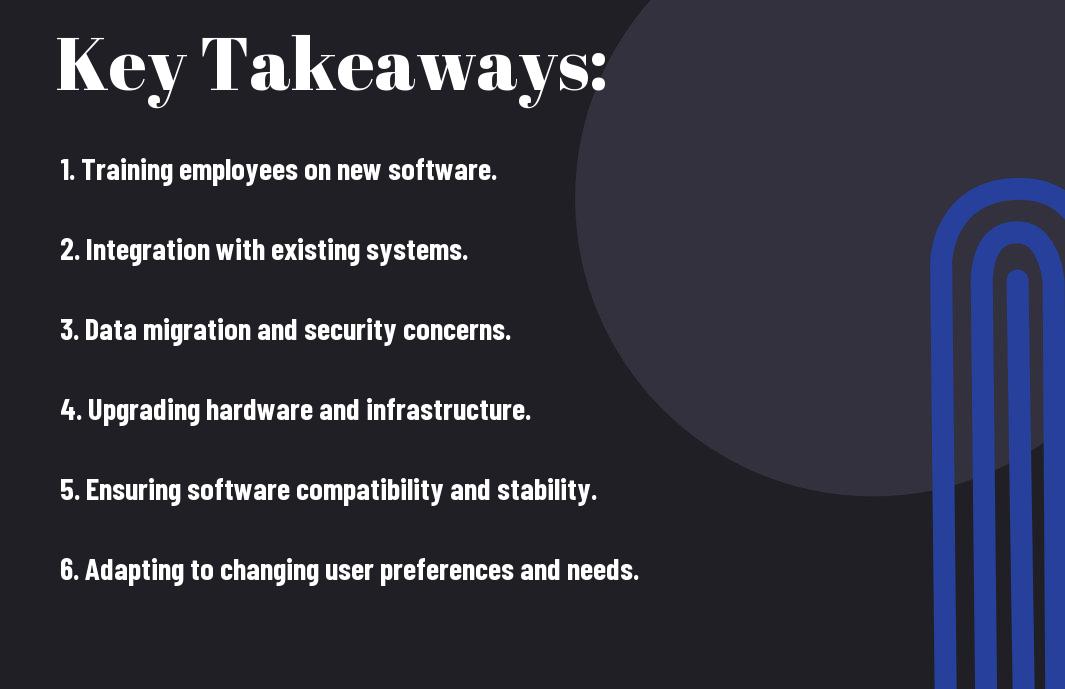Just as businesses evolve, so does technology. When you decide to transition to software services, you are initiateing on a journey that can bring about numerous challenges. From adapting to new processes and training employees to addressing compatibility issues and ensuring data security, the road to implementing software services is not without its obstacles. In this article, we will explore some of the common challenges that businesses like yours may encounter during this transition.
Key Takeaways:
- Integration: Businesses may face challenges when integrating new software services with their existing systems and processes.
- Data Migration: Moving data from old systems to new software services can be a complex and time-consuming task.
- User Training: Transitioning to software services often requires employees to learn new tools and processes, which can result in resistance and decreased productivity.

Technological Challenges
A 9 Challenges of Enterprise Software Development can arise when transitioning to software services for your business. These challenges can range from integration issues to data security concerns. Let’s investigate into some of the technological hurdles you may face during this transition.
Integration with Existing Systems
An vital challenge you might encounter is integrating new software services with your existing systems. This process can be complex, as different systems may have incompatible formats or structures. Ensuring seamless communication and data exchange between the old and new systems is crucial for the overall efficiency of your business operations.
Data Migration and Security Concerns
Systems must be moved from legacy systems to modern ones, and this comes with its own set of challenges. Another critical aspect to consider is the security of your data during the migration process. Ensuring that sensitive information is protected and remains secure throughout the transition is paramount. Implementing robust security measures and protocols is vital to safeguard your data from potential threats and breaches.
Cultural Shifts
Resistance to Change from Employees
Little do you realize that transitioning to software services within your business is not just about implementing new technology—it involves a significant cultural shift. One of the main challenges you might face is resistance to change from your employees. They may feel apprehensive about letting go of familiar processes and systems, fearing that their roles or routines might be disrupted.
Adapting to New Workflows and Processes
To adapt to new workflows and processes as your business transitions to software services, you must be prepared for some initial challenges. The integration of new software may require your employees to learn new tools and approaches, which can be met with resistance or confusion. However, it is crucial to provide adequate training and support to help your team navigate these changes effectively.
Change in workflows and processes can also impact the overall productivity and efficiency of your business. It may take some time for your team to fully embrace and master the new software tools, but with the right resources and guidance, the transition can lead to improved performance and streamlined operations.

Financial Burdens
High Upfront Costs and ROI Expectations
For businesses transitioning to software services, financial burdens can arise due to the high upfront costs associated with implementing new technologies. You may need to invest a significant amount of capital in purchasing software licenses, hardware upgrades, and training for your employees. This can strain your financial resources, especially if you are a small or medium-sized enterprise with limited funds.
Ongoing Maintenance and Update Expenses
Updating software regularly is crucial to ensure smooth operations and protect your business from security threats. However, these ongoing maintenance and update expenses can add up over time, increasing the overall cost of software services. It’s crucial to factor in these expenses when budgeting for your transition to software services to avoid unexpected financial strains.
Costs associated with ongoing maintenance and updates include subscription fees for software upgrades, IT support services for troubleshooting, and employee training to adapt to new software features. By planning for these expenses in advance and setting aside a budget for regular maintenance, you can minimize the financial burden of transitioning to software services.
Talent Acquisition and Retention
Finding Skilled Professionals for Software Development
Now, as your business transitions to software services, one of the significant challenges you might face is finding skilled professionals for software development. The demand for talented developers often exceeds the available supply, making it competitive to attract top talent. You may encounter difficulties in recruiting individuals with the right skills and experience to support your software service offerings.
Retaining Existing Employees during Transition
Skilled professionals who have been with your organization for a long time may feel uncertain or concerned about the transition to software services. They may worry about their job security, changes in their roles, or potential disruptions to their work routines. It’s vital to reassure your existing employees during this time of change and provide them with the necessary support to adapt to new technologies and methodologies.
Retention strategies such as offering training programs, career development opportunities, and clear communication about the transition plans can help retain valuable employees. Acknowledging their concerns and involving them in the transition process can also boost their morale and commitment to the new direction of the business.

Customer Impact
Once again, as you venture into transitioning your business to software services, it is crucial to consider the impact on your customers. Customer satisfaction and loyalty are central to the success of any business. During this transition, managing customer expectations becomes paramount. You may encounter challenges in delivering the same level of service or product quality during the initial phases of software integration. Addressing customer concerns promptly and transparently is key. If you want to examine deeper into the potential software development issues, you can explore What do you think are the biggest software development issues in small to medium businesses?
Managing Customer Expectations during Transition
Customer expectations play a crucial role in the success of your transition to software services. As you make changes to your systems and processes, it is vital to communicate effectively with your customers. Keeping them informed about any potential disruptions or changes to their user experience can help manage their expectations. Be transparent about the benefits they can expect once the transition is complete. By maintaining open lines of communication, you can foster trust and loyalty among your customer base.
Ensuring Seamless User Experience
During the transition to software services, ensuring a seamless user experience is vital. Your customers should be able to navigate your new software easily and without disruptions. Conducting user testing and gathering feedback can help you identify any pain points in the user experience. By proactively addressing these issues, you can enhance customer satisfaction and retention. Do not forget, a smooth transition for your customers is key to the overall success of your software integration.
Ensuring a seamless user experience involves optimizing your software for usability and performance. Consider offering training sessions or resources to help your customers adapt to the new software smoothly. By prioritizing user experience, you can differentiate your business and create a loyal customer base that values the convenience and efficiency of your software services.
Organizational Structure
Unlike traditional business models, transitioning to software services requires a significant shift in organizational structure. This change impacts how roles and responsibilities are defined, how teams collaborate, and how decisions are made. It can be challenging for businesses to navigate this new terrain and ensure a smooth transition.
Redefining Roles and Responsibilities
An crucial challenge businesses face when moving to software services is redefining roles and responsibilities within the organization. As software services typically involve cross-functional teams working on agile projects, individuals may need to take on multiple roles and work closely with colleagues from different departments. This shift can be jarring for employees accustomed to more siloed ways of working, leading to confusion and resistance.
Creating a Culture of Continuous Learning
Culture plays a pivotal role in the successful transition to software services. Embracing a culture of continuous learning is crucial for employees to adapt to new technologies, methodologies, and ways of working. In a rapidly evolving tech landscape, businesses must encourage employees to upskill, reskill, and stay updated on industry trends to remain competitive and innovative.
Plus, fostering a culture of continuous learning not only benefits individual employees but also enhances the organization’s overall adaptability and resilience. By investing in employee development and creating opportunities for ongoing growth, businesses can better position themselves for success in the dynamic world of software services.
Conclusion
With these considerations in mind, you now have a better understanding of the challenges that businesses may encounter when transitioning to software services. It’s important to anticipate potential obstacles such as integration issues, data security concerns, and employee resistance. By being proactive and addressing these challenges head-on, you can pave the way for a successful transition to software services.
Remember that each business is unique, and the challenges you face may vary depending on your industry, size, and existing technology infrastructure. Take the time to assess your specific needs and develop a strategic plan to mitigate risks and maximize the benefits of adopting software services. With careful planning and proper guidance, you can navigate the transition process smoothly and position your business for long-term success in the digital age.
Q: What are some challenges businesses might face when transitioning to software services?
A: Some common challenges businesses might face when transitioning to software services include:
- Resistance to change from employees accustomed to traditional methods
- Integration issues with existing systems and processes
- Concerns about data security and privacy when moving to cloud-based solutions
Q: How can businesses address resistance to change during the transition to software services?
A: To address resistance to change, businesses can:
- Provide training and support to help employees adapt to new software tools
- Communicate the benefits of the transition and how it will improve efficiency and productivity
- Involve employees in the decision-making process and listen to their feedback
Q: What steps can businesses take to ensure a smooth integration of software services with existing systems?
A: To ensure a smooth integration, businesses can:
- Conduct a thorough assessment of their current systems and processes
- Work closely with software service providers to customize solutions to fit their specific needs
- Implement a phased approach to implementation, testing each stage before full deployment



